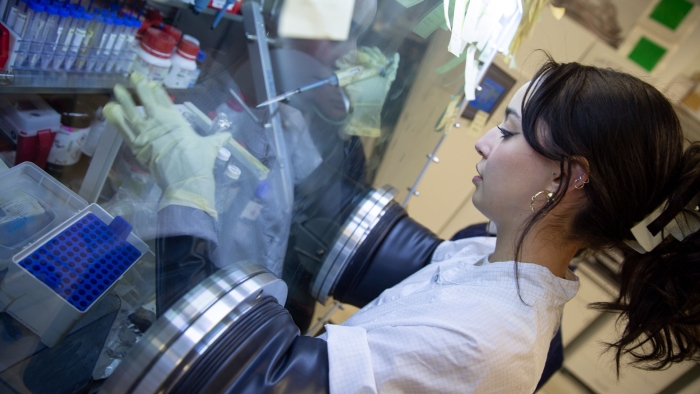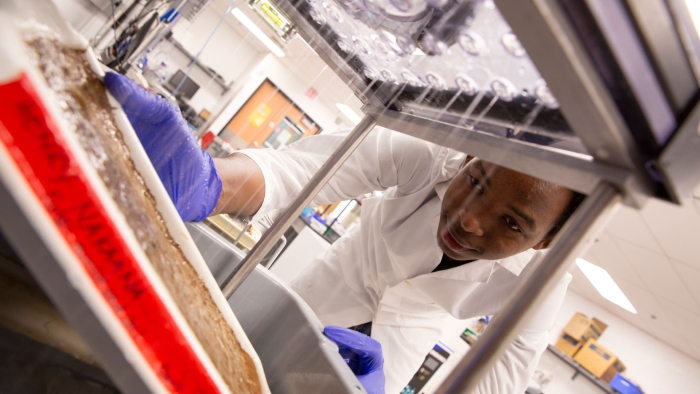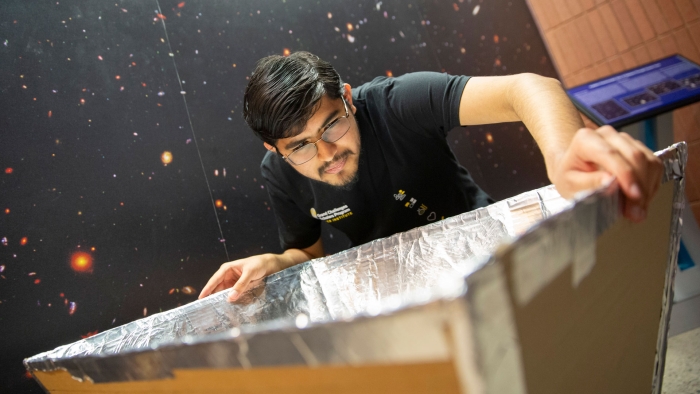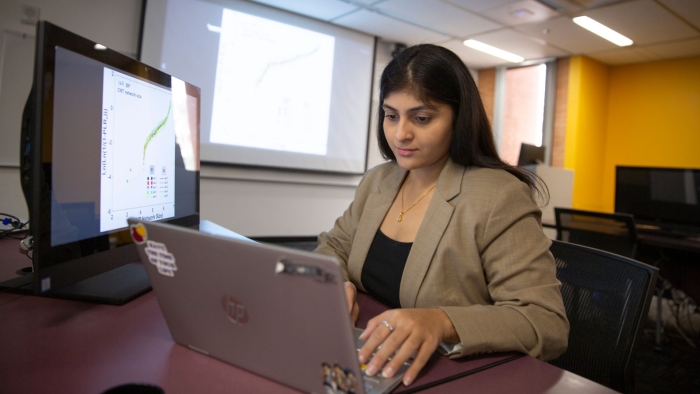Meet student researchers solving real-world challenges

Henry Nakaana, a civil engineering major in the Ira A. Fulton Schools of Engineering at Arizona State University, works with samples of soil and fungus to create a solution for soils affected by wildfire as a participant in the Fulton Undergraduate Research Initiative program. Nakaana is one of many student researchers helping to solve real-world problems with hands-on research. Photographer: Erika Gronek/ASU
Developing sustainable solar energy solutions, deploying fungi to support soils affected by wildfire, making space education more accessible and using machine learning for semiconductor material discovery — these are just some of the ways students at Arizona State University are addressing real-world challenges through hands-on research.
At the Ira A. Fulton Schools of Engineering at ASU, undergraduate and graduate students have several opportunities to conduct use-inspired research in which they can apply their classroom knowledge and build new skills. Through individual projects mentored by Fulton Schools faculty members, students deliver innovation that matters in the research themes of data science, education, energy, health, security, semiconductor manufacturing and sustainability.
The Fulton Undergraduate Research Initiative, or FURI, and the Master’s Opportunity for Research in Engineering, or MORE, programs give participants valuable experiences in which they conceptualize ideas, develop plans and investigate their research questions over a semester.
Students participating in the Grand Challenges Scholars Program, or GCSP, can apply for additional funding to conduct research through the GCSP research stipend program. Conducting research is part of a GCSP student’s rigorous competency requirements designed to prepare them to solve complex global societal challenges.
These three programs enhance students’ ability to innovate, think independently and solve problems in their communities. They also benefit from the technical and soft skills they gain, which prepare them for their careers and the pursuit of advanced degrees.
Each semester, students who participate in FURI, MORE and the GCSP research stipend program are invited to present their findings at a poster session. The Fulton Forge Student Research Expo is the culmination of the students’ hard work to forge meaningful research paths and connections to make an impact.
Learn about four students who are participating in the spring 2024 Fulton Forge Student Research Expo. Meet them and more than 100 other student investigators at the event, which is open to the public, on Friday, April 19, from 1 to 3 p.m. at the Student Pavilion on the ASU Tempe campus.
Clara Chaves Azevedo
Civil engineering major Clara Chaves Azevedo is conducting research to reduce the toxicity of promising perovskite materials to implement solar energy generation on windows with faculty mentor Nick Rolston, an assistant professor of electrical engineering. Chaves Azevedo is a second-semester first-year student — the earliest a Fulton Schools student can participate in FURI.
Question: How will your engineering research project impact the world?
Chaves Azevedo: The project as a whole is a new opportunity to collect more solar energy and make it more accessible. Solar energy is clean and cheap; therefore, it will positively impact how society gathers energy and reduces the use of sources that harm the environment. My specific research is to find an even more sustainable solution. Instead of using lead to produce the panels, I propose using tin, making it a less toxic option.
Q: What has been your most memorable experience as a student researcher in this program? Did you have a particular “aha!” moment during your project?
Chaves Azevedo: My most memorable experience was being able to see what my samples actually looked like under a microscope. It was fascinating to see how something that looks so simple to the naked eye can appear so complex and beautiful under a microscope.
Q: How do you see this experience helping with your career or advanced degree goals?
Chaves Azevedo: As a civil engineer with a focus on sustainability, my ambition is to harmoniously integrate the principles of environmental consciousness and engineering expertise to construct homes that minimize adverse impacts on our planet.
In addition to the intrinsic value of engaging in research, I find that the experience enriches my skill set by fostering creativity, honing research capabilities and refining my communication aptitude, among other things.
Furthermore, I am particularly enthralled by the prospect of incorporating solar panel windows into residential construction, as it represents a tangible manifestation of my commitment to sustainable innovation and architectural excellence.
Henry Nakaana
Civil engineering first-year student Henry Nakaana’s FURI project with Emmanuel Salifu, an assistant professor of civil and environmental engineering, involves engineering fungi that could help support areas affected by increasingly frequent wildfires and heavy rains that make soil vulnerable to erosion and landslides.
Q: What made you want to get involved in FURI and the project you’re working on?
Nakaana: I joined FURI to gain experience in research, obtain knowledge that can help me improve my career and technical engineering skills, and also contribute valuable insights to the scientific community. My project explores the engineered growth of fungi as a novel method to improve stability and erosion resistance on post-wildfire soils. I chose this project because it aligns with my passion for using nature-based solutions to solve engineering problems.
Q: How will your engineering research project impact the world?
Nakaana: Today the occurrence of wildfires is expected to increase greatly in the northern parts of the U.S. and Canada, which will leave soil exposed to erosion and landslides. My research project offers an effective, budget-friendly and fast way to protect post-wildfire soils compared to other available solutions. My project also shows the additional advantages of using fungi on soil such as carbon sequestration, which helps reduce global climate change.
Q: What has been your most memorable experience as a student researcher?
Nakaana: One of my most memorable moments was when I realized the initial fungi growth on the soil. It was so amazing how fungi can grow in as little as two days to cover the whole soil surface. It made me feel more like an explorer uncovering secrets in a scientific space whose potential has not been discovered.
Q: How do you see this experience helping with your career or advanced degree goals?
Nakaana: The unique combination of engineering and ecological considerations in this project aligns perfectly with my career aspirations to use sustainable technology. Furthermore, this experience not only adds depth to my academic qualifications but also establishes a valuable network within the scientific community on a research topic that is just growing globally.
Collaborating with experts in the field through my mentor has broadened my perspective and allowed me to contribute to cutting-edge research. These aspects, combined with the tangible outcomes of the project, will increase my credibility and open doors to opportunities for further education and advancement in my engineering career.
Ritwik Sharma
Aerospace engineering sophomore Ritwik Sharma is working on a cross-disciplinary project with Daniel C. Jacobs, an assistant professor in the ASU School of Earth and Space Exploration, to share his passion for space. His work, funded by the GCSP research stipend opportunity, involves developing a wayfinding method for the Completely Hackable Amateur Radio Telescope, known as CHART, an inexpensive and simple way to use radio waves to see features in outer space not visible to the human eye. He aims to make the system more accessible for individuals and K–12 classroom instruction.
Q: How will your research project impact the world?
Sharma: The guidance system I am designing for CHART will give K–12 students a way to understand how astronomers observe different parts of the universe with radio telescopes. This will improve their understanding of astronomy as a field by teaching them how astronomers locate objects in the sky, and why they have to rely on coordinates as opposed to general directions.
Since the Earth is constantly revolving around the sun, our frame of reference is constantly changing, which makes coordinate systems like right ascension and declination and galactic an important part of the subject because they make tracking objects like galaxies and nebulae easier.
Q: How do you see this experience helping with your career or advanced degree goals?
Sharma: I plan to pursue a doctorate after I graduate from ASU, and I see this experience helping me by showing my future supervisors that I am capable of pursuing a project on my own, under the instruction of a mentor. This arrangement is common in graduate school where students work under the direction of their advisor on projects like their theses, dissertations or other items necessary to complete their doctoral or master’s degree. By showing my ability to work efficiently on a project like this, I can also show my future thesis advisor that I will be perfectly capable of completing something like a doctoral thesis, which will give me an advantage over other applicants.
Aishwarya Katkar
Mechanical engineering graduate student Aishwarya Katkar says her degree program provides a versatile foundation that can make meaningful impacts in many industries, including semiconductor manufacturing. In her research with the MORE program under the guidance of Masoud Yekani Fard, an assistant teaching professor specializing in mechanical and aerospace engineering, Katkar is using machine learning to help expedite material analysis to develop semiconductor device components.
Q: How will your engineering research project impact the world?
Katkar: One of the primary challenges in materials testing and analysis is the significant time investment required. We aim to implement machine learning techniques to expedite the process. Our goal is to automate the identification of novel materials with specific properties by analyzing nanoparticles and the spaces between them. This approach will enable us to understand various material characteristics, such as electrical conductivity, more efficiently.
By streamlining the material analysis process, we can enhance the quality of materials used in semiconductor manufacturing. This innovative method will save time by eliminating the need for manual analysis, resulting in a smoother and more efficient process overall.
Q: How do you see this experience helping with your career/advanced degree goals?
Katkar: This experience holds immense significance for my career trajectory, particularly as a mechanical engineer with a background primarily rooted in design software. While my expertise in design software is undoubtedly valuable, this research opportunity has helped me broaden my horizons, particularly in the realm of material science. Integrating machine learning into material analysis has not only deepened my understanding of this critical aspect of engineering but has also expanded my skill set in the emerging field of machine learning.
This experience has made me confident in my ability to learn independently and has better equipped me to tackle multifaceted engineering challenges and make meaningful contributions to innovative projects in the field. Furthermore, it enhances my qualifications for a master's degree program and diverse career opportunities, bridging the gap between my existing skills and the broader knowledge essential for success in mechanical engineering.
More Science and technology

ASU postdoctoral researcher leads initiative to support graduate student mental health
Olivia Davis had firsthand experience with anxiety and OCD before she entered grad school. Then, during the pandemic and as a result of the growing pressures of the graduate school environment, she…

ASU graduate student researching interplay between family dynamics, ADHD
The symptoms of attention deficit hyperactivity disorder (ADHD) — which include daydreaming, making careless mistakes or taking risks, having a hard time resisting temptation, difficulty getting…

Will this antibiotic work? ASU scientists develop rapid bacterial tests
Bacteria multiply at an astonishing rate, sometimes doubling in number in under four minutes. Imagine a doctor faced with a patient showing severe signs of infection. As they sift through test…



